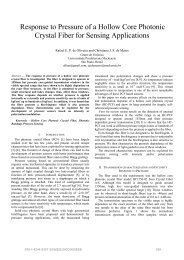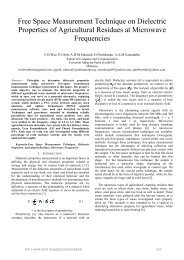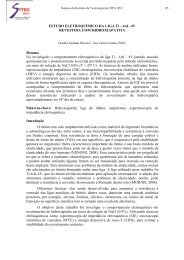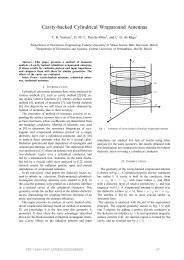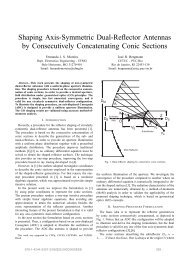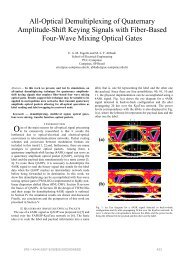A Variable Output Power, High Efficiency, Power Amplifier for the ...
A Variable Output Power, High Efficiency, Power Amplifier for the ...
A Variable Output Power, High Efficiency, Power Amplifier for the ...
Create successful ePaper yourself
Turn your PDF publications into a flip-book with our unique Google optimized e-Paper software.
A <strong>Variable</strong> <strong>Output</strong> <strong>Power</strong>, <strong>High</strong> <strong>Efficiency</strong>, <strong>Power</strong><strong>Amplifier</strong> <strong>for</strong> <strong>the</strong> 2.45 GHz ISM BandSajjad Ahmed, Ahmed Sayed, Henrique Portela, Olof Bengtsson*, Georg BoeckMicrowave Engineering Laboratory, Berlin University of TechnologyEinsteinufer 25, 10587 Berlin, Germany*Ferdinand-Braun-Institut für HoechstfrequenztechnikGustav-Kirchhoff-Str. 4,12489 Berlin, Germanysayed@mwt.ee.tu-berlin.deAbstract— This paper, presents <strong>the</strong> design and evaluation of ahigh efficiency, 30 W, two-stage, power amplifier <strong>for</strong> <strong>the</strong> 2.45GHz ISM band. The designed amplifier targets an industrialapplication where precise control over <strong>the</strong> output power withgood efficiency is necessary. A saturated output power of44.7 dBm (30 Watts) was reached at a maximum drain efficiencyof 67.8 %. A full 5 dB control of <strong>the</strong> output power was achievedby varying <strong>the</strong> gate bias of <strong>the</strong> driver stage. A minimum poweradded efficiency of 39.4% was reached over <strong>the</strong> full controllableoutput power range at <strong>the</strong> design frequency. The saturatedoutput power over a 150 MHz bandwidth around <strong>the</strong> designfrequency was more than 44 dBm with a power added efficiencyof more than 60 %.I. INTRODUCTIONRadio frequency (RF) commonly refers to high frequencyradio communication but <strong>the</strong>re is an entirely different categorywhere RF devices are used <strong>for</strong> non-communication purposes.The frequency band utilized <strong>for</strong> <strong>the</strong>se applications is known asIndustrial, Scientific and Medical (ISM) band and applicationsin this band are centred at different frequencies ranging from afew MHz to <strong>the</strong> mm-wave range [1]. Applications at ISMbandwere <strong>for</strong> a long time considered as non-commercial butrecently <strong>the</strong>se bands have seen a greater commercial interest,mainly because <strong>the</strong>y are now also utilized <strong>for</strong> communicationlike WiFi and Bluetooth applications. O<strong>the</strong>r applicationswhich fall under <strong>the</strong> ISM category include RF heating, plasmagenerators, laser exciters, RF lighting, medical telemetry,magnetic resonance imaging and many o<strong>the</strong>rs [1]. In some of<strong>the</strong> applications, <strong>the</strong> RF output power (P OUT ) is a few miliwattswhere as it might reach hundreds of watts in o<strong>the</strong>rapplications. Traditionally <strong>the</strong> vast amount of power used inheating applications have ruled out solid-state solutions butrecent technology development and application demands arenow starting to make transistor solutions a cost efficientalternative [2],[3]. For <strong>the</strong> heating application this work istargeting, moderate power but controllability of <strong>the</strong> outputpower is of main concern. The amount of output powerdirectly relates to <strong>the</strong> temperature of <strong>the</strong> heated object. <strong>High</strong>efficiency is needed over <strong>the</strong> full output range to reduceoperating cost, size and <strong>the</strong> cost of additional heat removinghardware.Lately, Gallium-Nitride (GaN) high electron mobilitytransistor (HEMT) technology has emerged as a highefficiency alternative to <strong>the</strong> mainstream Silicon LDMOStechnology <strong>for</strong> high power applications in <strong>the</strong> 10 W to 300 Wpower ranges below 3 GHz. With its high breakdown field,GaN high-power devices can be made small <strong>the</strong>reby reducing<strong>the</strong> parasitic losses and increasing <strong>the</strong> efficiency [4]. In [5] a50 dBm output power with 15 dB power gain and 63 % drainefficiency (η) is presented where as in [6], drain efficiency (η)of 50 %, output power of 250 W and 15 dB power gain hasbeen reported.In this paper, a two stage, 30 W PA at <strong>the</strong> 2.45 GHz ISMband is presented. GaN-HEMT technology is used <strong>for</strong> <strong>the</strong> highefficiency power stage and Si-LDMOS technology is used <strong>for</strong>improved gain controllability in <strong>the</strong> driver stage. Part IIhighlights <strong>the</strong> design of <strong>the</strong> amplifier, concept,implementation and realization. In part III <strong>the</strong> amplifier isevaluated, under small signal operation <strong>for</strong> model verificationand under large signal conditions, simulations are compared tomeasurements under all conditions. Part IV is a briefdiscussion of <strong>the</strong> possibilities with <strong>the</strong> design and in part V <strong>the</strong>work is concluded.II. AMPLIFIER CONCEPT AND DESIGNIn <strong>the</strong> application, <strong>the</strong> power amplifier is to delivermicrowave power up to 30 W (44.8 dBm) at 2.45 GHz withprecise control of output power with high efficiency at aconstant available input power of 100 mW (20 dBm).Considering <strong>the</strong>se specifications a two-stage amplifier wasdesigned with a Cree AlGaN/GaN HEMT (CGH40025H)transistor <strong>for</strong> <strong>the</strong> power stage (PS) and a Freescale Si LDMOS(MW6S004N) transistor <strong>for</strong> <strong>the</strong> driver stage (DS). A blockdiagram <strong>for</strong> <strong>the</strong> two-stage amplifier is shown in Fig. 1.sourceInputmatchingDriver stageInterstagematchig<strong>Power</strong> StageFig. 1 Block diagram <strong>for</strong> two stage power amplifier<strong>Output</strong>matchingLoadThe high power density of GaN makes <strong>the</strong> device size verysmall which corresponds to high impedances at source andload compared to o<strong>the</strong>r devices which in-turn makes matchingeasier [7]. The selection of Si LDMOS transistor <strong>for</strong> <strong>the</strong> driverstage is primarily because of its high gain and high drainvoltage characteristics. To achieve <strong>the</strong> objective of high978-1-4244-5357-3/09/$26.00©2009IEEE 821
efficiency <strong>the</strong> transistors are biased towards class B operation.The amplifier was designed <strong>for</strong> a drain supply (V D ) of 28V.A. Design ProcedureLarge-signal models were available <strong>for</strong> both transistorsfrom <strong>the</strong> manufacturers. Although <strong>the</strong>ir validity could bequestioned <strong>the</strong>y were later shown to well model <strong>the</strong> behaviourunder <strong>the</strong> conditions used in this design. Initially harmonicbalance,load-pull simulations were conducted in Agilent-ADS to establish a high power added efficiency (PAE) at <strong>the</strong>requested output power <strong>for</strong> <strong>the</strong> power stage. The trade-offbetween output power, gain, efficiency and quiescent pointwas observed in <strong>the</strong> simulations and an optimal quiescentcurrent of around 10 % and 5 % of <strong>the</strong> maximum saturateddrain current <strong>for</strong> both power and driver stage respectivelywere determined to achieve <strong>the</strong> desired objectives of outputpower and efficiency. Independent load and source-pullsimulations were <strong>the</strong>n per<strong>for</strong>med <strong>for</strong> both stages. Initially,load and source-pull simulations were per<strong>for</strong>med with idealcomponents and ideal optimum load and source impedanceswere found. Independently both transistors were stabilized tounconditional stability by fulfilling <strong>the</strong> Rollet’s stabilitycriterion [8] (K > 1). This was achieved by adding a parallelresistance with capacitance in series at <strong>the</strong> input, effectivelyreducing <strong>the</strong> low frequency gain. λ/4 transmission lines wereused in <strong>the</strong> biasing networks to improve isolation at RFfrequency. Load and source pull simulation were per<strong>for</strong>medagain to achieve optimum impedances <strong>for</strong> <strong>the</strong> two stages. Theoptimum load and source impedances found are summarizedTable I. A maximum optimum driver stage quiescent current(IDQ (DS) ) was found to be 32 mA at an optimum power stagequiescent current (IDQ (PS) ) of 123 mA.TABLE IOPTIMUM LOAD AND SOURCE IMPEDANCE AND QUIESSENTCURRENT<strong>Power</strong> stage(PS)Driver stage(DS)Z LOAD[]Z SOURCE[]I DQ[mA]6.2 – j10.3 6.7 – j26.5 1236.0 – j6.6 5.0 – j30.0 32B. Design ImplementationThe matching networks were realized using micro-striplines toge<strong>the</strong>r with open stubs in low pass <strong>for</strong>m. Inputmatching was designed to achieve good return loss. It wasimplemented using a tapered line to compensate <strong>for</strong> some of<strong>the</strong> series capacitance introduces by <strong>the</strong> capacitor in <strong>the</strong>stabilizing network. The inter-stage matching network wasdesigned to minimize mismatch losses and <strong>for</strong> maximumtransfer of power between <strong>the</strong> two stages. The outputmatching network was designed <strong>for</strong> minimum loss to <strong>the</strong> loadand a simulated insertion loss < 0.1 dB was achieved <strong>for</strong> afrequency range of 200 MHz with centre frequency of2.45 GHz. Momentum simulations were used to verify <strong>the</strong>impedances created by <strong>the</strong> linear matching networks.C. Design RealizationThe amplifier was built on Rogers RO4003 substrate with adielectric constant ε r of 3.66 and thickness of 0.51 mm. Fig. 2shows a prototype <strong>for</strong> <strong>the</strong> designed PA.Fig. 2 <strong>Power</strong> amplifier prototypeVia holes were manually fabricated. Thermal control wasestablished using an aluminium heat sink with a cooling fan.Bias was separately controllable <strong>for</strong> <strong>the</strong> two stages in <strong>the</strong>initial tests but was later fixed <strong>for</strong> <strong>the</strong> power stage andintegrated with a temperature-gain control circuitry. Thematching networks were made on separate substrates so thatlinear per<strong>for</strong>mance of <strong>the</strong> networks could be measured andverified individually.III. AMPLIFIER EVALUATIONThe design process was totally based on a model approach.Small signal evaluation was <strong>the</strong>re<strong>for</strong>e used to verify <strong>the</strong>correctness of <strong>the</strong> models used <strong>the</strong>reby validating <strong>the</strong> designprocess.A. Small Signal Per<strong>for</strong>manceThe small-signal s-parameters of <strong>the</strong> full amplifier are showin Fig. 3.S-Parameters [dB]40200-20-40S21simS11simS22simS21measS22measS11meas2.0 2.2 2.4 2.6 2.8 3.0ƒ [GHz]Fig. 3 Measured and simulated small signal s-parameters at V D = 28 V andmaximum drain current <strong>for</strong> <strong>the</strong> driver stage.It can be observed that a small-signal gain of 27 dB withinput and output reflections less than -15 dB in <strong>the</strong> operatingfrequency is achieved. The K factor was measured to > 4 over<strong>the</strong> frequency band from 1 kHz – 10 GHz. This is mainlybecause both <strong>the</strong> stages were individually stabilized be<strong>for</strong>ecascading. Compared to simulations, gain measurements2009 SBMO/IEEE MTT-S International Microwave & Optoelectronics Conference (IMOC 2009) 822
exhibit some degradation although <strong>the</strong> main behaviour is verywell tracked by <strong>the</strong> simulations. The small discrepancy is acombination of many factors, transistor model in-accuracy,tolerance of <strong>the</strong> used devices and tolerance in <strong>the</strong> fabricatedboards.B. <strong>Power</strong> Per<strong>for</strong>mance at Maximum BiasA signal generator toge<strong>the</strong>r with a pre-amplifier was usedas power source in order to generate desired maximumavailable input power (P AVS ) of 20 dBm during <strong>the</strong> powermeasurements. Initially <strong>the</strong> maximum operating per<strong>for</strong>mancewas tested at maximum driver stage biasing, I DQ(DS) = 32 mA.The measured results of output power, transducer power gain(Gain), drain efficiency and power added efficiency are shownin Fig. 4 and Fig. 5.P OUT[dBm], Gain [dB]50403020Gainsim [dB] Gainmeas[dB]Poutsim [dBm] Poutmeas [dBm]105 10 15 20 25Fig. 4 Measured and simulated gain and output power per<strong>for</strong>mance at V D =28 V, I DQ(DS) = 23 mA and I DQ(PS) = 123 mA.80C. <strong>Power</strong> Per<strong>for</strong>mance over BandwidthAlthough <strong>the</strong> amplifier was designed <strong>for</strong> a fixed frequencyuse at 2.45 GHz <strong>the</strong> ISM band allows some frequencymodulation of <strong>the</strong> signals. The amplifier was <strong>the</strong>re<strong>for</strong>emeasured over a limited bandwidth around <strong>the</strong> designfrequency. Fig. 6 shows <strong>the</strong> power per<strong>for</strong>mance at saturationover a 150 MHz frequency range.PA Per<strong>for</strong>mance806040200Gainsim [dB] Gainmeas [dB]PAEsim [%] PAEmeas [%]Poutsim [dBm] Poutmeas [dBm]2.35 2.40 2.45 2.50ƒ [GHz]Fig. 6 <strong>Output</strong> power and PAE <strong>for</strong> a frequency range of 150 MHz at V D = 28V, I DQ(DS) = 23 mA and I DQ(PS) = 123 mA.An output power of more than 29 W and a PAE of morethan 60 % could be measured over <strong>the</strong> full 150 MHzbandwidth. Very good agreement was also found over <strong>the</strong>band between simulated and measured results.D. <strong>Power</strong> Per<strong>for</strong>mance over Gain ControlThe gain of <strong>the</strong> amplifier is controlled by setting <strong>the</strong> gatevoltage of <strong>the</strong> driver stage LDMOS <strong>the</strong>reby adjusting I DQ(DS) .Fig. 7 shows <strong>the</strong> output power controllability of <strong>the</strong> amplifier.46<strong>Efficiency</strong> [%]604020P OUT[dBm]4442sim [%] PAEsim [%]meas [%] PAEmeas [%]05 10 15 20 25Input <strong>Power</strong>dBmFig. 5 Measured and simulated drain efficiency and PAE at V D = 28 V, I DQ(DS)= 23 mA and I DQ(PS) = 123 mA.A saturated output power of 44.8 dBm (30 W) and a gain of25 dB was achieved. The maximum drain efficiency is 67.8 %at saturated power along with an almost similar PAE due to<strong>the</strong> high gain of <strong>the</strong> amplifier. Very good agreement betweensimulation and measurements were observed.40P OUT(meas)P OUT(sim)380 10 20 30 40IDS_Driver [mA]Fig. 7 Measured and simulated power control at f = 2.45 GHz. V D = 28 V,and I DQ(PS) = 123 mA.As shown <strong>the</strong> controllability tracks very well <strong>the</strong> simulatedvalues. By varying <strong>the</strong> current of <strong>the</strong> driver stage between3 mA and 33 mA at a constant input power (P IN ) at 100 mW(20 dBm) a measured tuneable range of 5 dB was achieved2009 SBMO/IEEE MTT-S International Microwave & Optoelectronics Conference (IMOC 2009) 823
(39 dBm to 44 dBm). This was somewhat less than <strong>the</strong> 6 dBexpected from simulations. The achieved PAE during powercontrol is shown in Fig. 8Gain [dB], PAE [%]70605040302010Gain (meas)PAE (meas)Gain (sim)PAE (sim)39 40 41 42 43 44P OUTdBmFig. 8 Measured and simulated gain and PAE during power control atf = 2.45 GHz. V D = 28 V and I DQ(PS) = 123 mA.From this figure it can be seen that a PAE of almost 40 % ismaintained <strong>for</strong> <strong>the</strong> two-stage amplifier over <strong>the</strong> full tuneablerange.IV. DISCUSSIONAlthough this amplifier was designed <strong>for</strong> heatingapplications at ISM band where power generated at o<strong>the</strong>rfrequencies is of little concern but <strong>the</strong> topology used may bevery suitable <strong>for</strong> more frequency sensitive applications [2]within <strong>the</strong> ISM band. This covers e.g. applications withincommunication and microwave enhanced chemical reactions.Fig. 9 represents <strong>the</strong> two-tone IMD per<strong>for</strong>mance of <strong>the</strong>designed amplifier.<strong>Output</strong> <strong>Power</strong> 2-tone [dBm]806040200-20-40-60P3(meas)P2(meas)P1(meas)P3(sim)P2(sim)P1(sim)IMD3 ~65 dBcV. CONCLUSIONSIn this paper <strong>the</strong> design of a two stage 30 W poweramplifier with controllable gain <strong>for</strong> <strong>the</strong> ISM band is presented.<strong>Power</strong> control and high efficiency over <strong>the</strong> controllable outputpower range were <strong>the</strong> main design objectives. A model baseddesign approach was used and verified in <strong>the</strong> work. <strong>High</strong> gainrequirement <strong>for</strong>ced it to be a two-stage amplifier where ashigh efficiency over <strong>the</strong> full controllable power range wasachieved using GaN HEMT technology in <strong>the</strong> power stageand Si-LDMOS technology in <strong>the</strong> driver stage. A gain of25 dB was measured <strong>for</strong> <strong>the</strong> two stage amplifier at <strong>the</strong>maximum output power of 30 W. In compression a drainefficiency of 67.8 % and PAE of 67.2 % was achieved. Theamplifier per<strong>for</strong>ms well over a full bandwidth of 150 MHzwith a saturated output power of more than 44 dBm at a PAE> 60% <strong>for</strong> <strong>the</strong> full band.The output power is controllable within a 5 dB range bysetting <strong>the</strong> bias of <strong>the</strong> driver stage. More than 40 % PAE ismaintained over <strong>the</strong> full controllable output power rangewhich makes <strong>the</strong> amplifier well suited <strong>for</strong> <strong>the</strong> heatingapplication it was designed <strong>for</strong>.ACKNOWLEDGMENTSThe authors would like to thank Cree <strong>for</strong> providing <strong>the</strong>model <strong>for</strong> <strong>the</strong> GaN-HEMT transistor used and Freescale <strong>for</strong>providing <strong>the</strong> model <strong>for</strong> <strong>the</strong> Si-LDMOS used.REFERENCES[1] “The ISM Revolution: The Next Big Thing”, By Iboun Taimiya Sylla,Texas Instruments, 9th Feburary, 2009, www.rfdesignline.com[2] Wojciech Wojtasiak, Daniel Gryglewski and Wojciech Gwarek,' “AlOOW ISM-2.45GHz BAND POWER TEST SYSTEM,” *Institute ofRadioelectronics, Warsaw University of Technology, Poland. Journalof telecommunications and in<strong>for</strong>mation technology, 2005.[3] Isao Takenaka, Hidemasa Takahashi, Kazunori Asano, JunkoMorikawa, Kohji Ishikura, Mikio Kanamori", Masaaki Kuzuhara andHiroaki Tsutsui, “<strong>High</strong> efficiency S-band 30W power GaAs FETs”ULSI Device Development Laboratories, NEC Corporation. 9-1,Seiran 2-Chome70tsu,Shiga 520,Japan.[4] A. H. Jardnal, “Large signal modelling <strong>for</strong> GaN devices <strong>for</strong> high poweramplifier”, PhD., University of Kassel, Germany, Nov. 2006.[5] Nitronex Corporation, “GaN <strong>Power</strong> HEMT <strong>for</strong> 2.5 GHz WiMAXApplications”, NPT25100, 2305 Presidential Drive. Durham, NC27703.[6] K. Krishnamurthy, M. J. Poulton, J. Martin, R. Vetury, J. Brown, and J.B. Shealy, “A 250 W S-Band GaN HEMT <strong>Amplifier</strong>”, InfrastructureProduct Line, RF Micro Devices, Inc., Charlotte, NC 28269, USA.[7] J. Shumaker, M. Ohoka, and N. Ui, “Design of <strong>Power</strong> <strong>Amplifier</strong>sUsing <strong>High</strong> Breakdown GaN HEMT Devices”, Eudyna Devices USAInc, and Eudyna Devices Inc Japan.[8] S. Cripps, “Advanced Techniques in RF <strong>Power</strong> <strong>Amplifier</strong> Design”, 1stEd., Artech House, 2002.-20 -10 0 10 20 30Input <strong>Power</strong> 2-tone [dBm]Fig. 9 Two-tone IMD per<strong>for</strong>mance of <strong>the</strong> amplifier <strong>for</strong> a tone-spacing of 100MHx at <strong>the</strong> deigns frequency 2.45 GHz at V D = 28 V, I DQ(DS) = 23 mA andI DQ(PS) = 123 mA.2009 SBMO/IEEE MTT-S International Microwave & Optoelectronics Conference (IMOC 2009) 824



